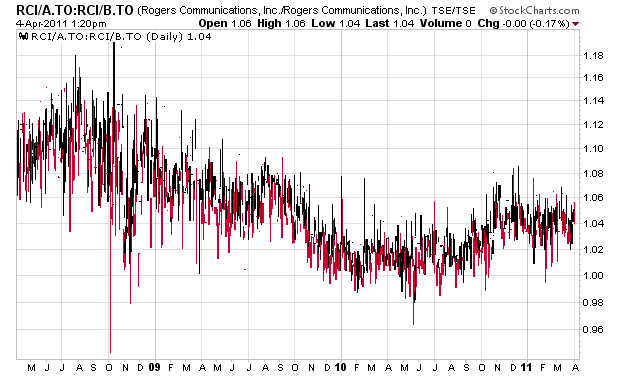As the Canadian election trail continues, media frequently comments on the dropping voter turnout over the past few elections. There may be an economic reason for the drop in turnout – mainly that as electoral districts increase in population, the value of a vote is subsequently less.
Trying to quantify the value of a vote in an election (e.g. if you could “sell” your vote, which is illegal) has always been an interesting academic exercise. However, there is real market data that could give some sort of insight to the matter. The data can be obtained from companies that have dual classes of shares which share the economic interests, but split the voting interests in the firm.
One example of this is Rogers Communications (TSX: RCI.A / RCI.B). Each class of shares has the same dividend and economic interest in the corporation, while the Class A shares give you one vote in the election to the board of directors. Rogers’ voting shares is 90% owned by a family trust and hence the shares trading are in a minority position. However, in the event of a buyout offer, Class A and Class B shares can receive different economic consideration.
Class A shares are relatively illiquid – they trade about 5,500 shares a day, while Class B shares are very highly liquid. However, the voting rights with Class A shares, offset by the liquidity penalty that the shares would have, trade approximately $1-2 higher than Class B shares. Measuring the ratio of Class A to Class B share values, you have the following rather interesting chart:
Over the past three years, the ratio has gone from about a 10% price differential to as low as 1%, and there has been some badly placed orders that have brought the ratio below 1 – which gives you the economic interests AND voting interests – presumably this is a discount for illiquidity.
Shaw Cable (SJR.A / SJR.B) also has a similar structure, with the voting shares having a slightly lower dividend than the non-voting B shares. The spread there, however, is about 20% and the voting shares are highly illiquid.
Although both of these examples are not a precise comparison since the voting shares are majority-owned and thus your vote in the voting shares are meaningless, it is an interesting exercise in measuring the value of a vote. I am sure readers out there can come up with better examples of companies that have dual class structures that do not have majority ownership on the voting shares.
